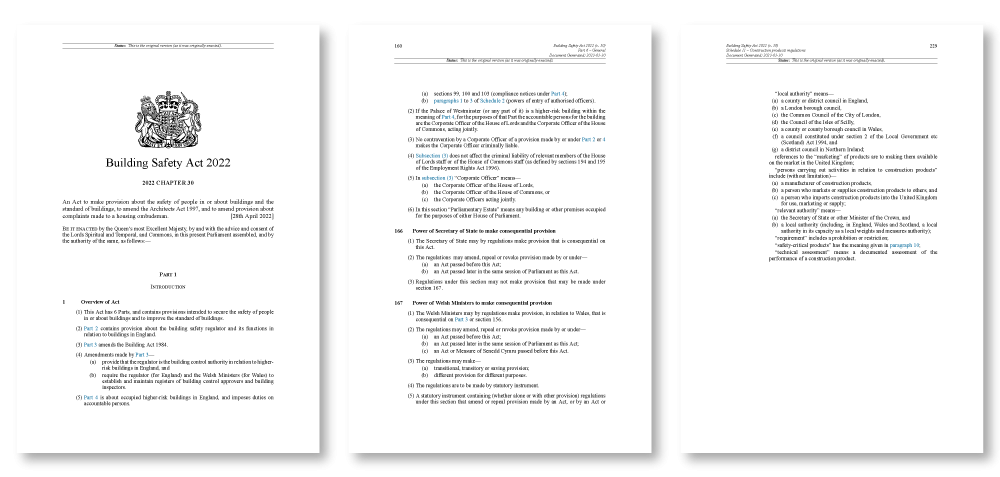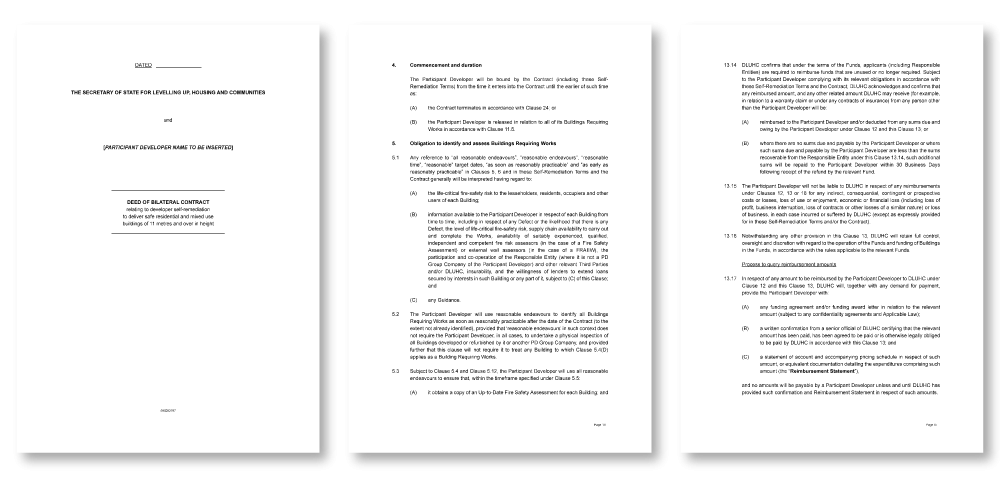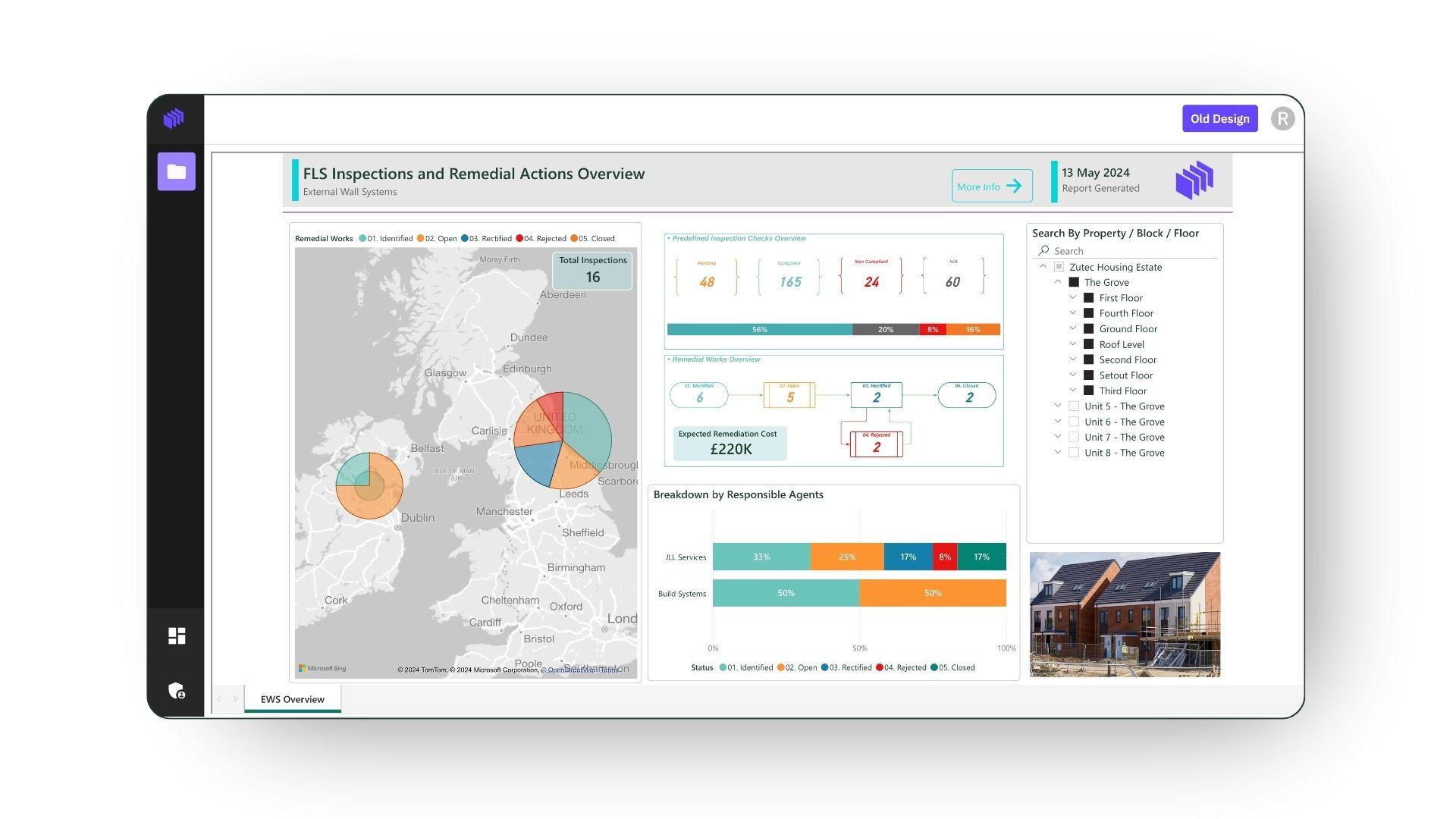Government cladding update
Recent months have seen renewed pressure put on developers from the Government to make buildings safe from life-critical fire safety defects, including cladding. The deadline has now passed for developers to sign contracts that will oblige them to remediate buildings, protecting thousands of leaseholders living in hundreds of unsafe buildings across England. Those failing to take responsibility have been named with the threat of being banned from the housing market.
In the wake of the Grenfell Tower fire, the Hackitt Review identified profound system failures surrounding the safety of residential buildings, especially high-rise buildings 18 metres and over in height. The misunderstanding or misinterpretation of regulation guidelines, tendencies to do things quickly and cheaply, ambiguity around roles and responsibilities, and inadequate tools to monitor oversight all reinforced the need to radically rethink building safety.
The ground-breaking reforms in The Building Safety Act 2022 (BSA) have instigated the biggest changes to building safety in our country’s history. The industry as a whole has been crying out for change, but legislation in this area is notoriously slow-moving.
When the national Building Act was first conceived of in England and Wales in back in 1840, it took some 144 years to come to pass as The Building Act 1984. Greater uniformity, accountability and governing principles that span both private and public sectors would provide the much-needed clarity of meaning and an improvement of building safety and building standards in general.
>> Get a Demo: Ready-to-go Cladding Remediation Compliance solution
When is the Building Safety Act coming into force?
The Building Safety Act 2022 is being rolled out in stages. The immediate response to the Grenfell disaster saw some decisive changes come into effect in June 2022, particularly surrounding a new regulatory regime. These included the updated definition of high-risk buildings to being 18m or more in height or having at least 7 storeys, assigning responsibility for cladding to landlords or developers, and the call for their immediate remediation, as well as the appointment of building safety managers in these high-risk buildings.
While the first provisions of the BSA 2022 have come into force, we expect to see further requirements implemented in 2023, including the three gateways for building information across planning, pre-construction and digital handover. This is known as having a ‘golden thread’ of information which comes into effect in October 2023.
As part of this, between April and October 2023 all approved persons (AP), which is the organisation or person who owns or has responsibility for a building, will need to register all their existing high-rise residential buildings (HRRBs) with the Building Safety Regulator (BSR), and it will be an offence if an occupied building is not registered after October 2023. An AP will be required to register any newly built HRRBs with the BSR before occupation after this date.
Additionally, an AP must prepare and maintain a building safety regime for each of their HRRBs, making a building safety case report available to the BSR at set periods and upon request, as well as a resident engagement strategy.
The safety case report contains all the information the approved person and asset owner require to manage the risk of fire and the structural safety of a building. Effectively, it is a risk assessment evidencing the control measures that have been implemented (fixed assets) and continue to be implemented (dynamic elements) to mitigate the spread of fire, and structural failure and reduce the seriousness of an incident if one should happen.
Digital and data are the essential building blocks of all successful organisations, and this should be no different for the built environment. This directive for accessible building safety information gives all the more reason to transform the sector to a digital future. We need to replicate the seamless and easy experience we’ve come to expect when buying our groceries or checking our bank balance, instead of working on siloed systems or struggling with incomplete big bulky project folders. This is why the government has an emphasis on digital with the BSA 2022.

What is the government cladding pledge?
As one of the first practical implications of the Building Safety Act 2022, the remediation of defects on high-risk buildings to meet required safety standards has been a priority for the Government.
For this reason, Michael Gove, Secretary of State for Levelling Up, Housing and Communities wrote to developers in January 2022 asking them to sign a pledge to take responsibility for performing and funding self-remediation works on all their high-rise buildings.
At the time, the 49 developers who signed up agreed in principle to reset building safety by committing to remediate life-critical fire safety works on buildings over 18 meters high that they had played a role in developing. Since then, the Department for Levelling Up, Housing and Communities (DLUHC) have determined the nature and scope of remediation works.
On 30 January this year, the DLUHC followed up by asking them to sign a contract to reinforce that commitment, requiring developers to address life-critical fire safety as soon as possible, while keeping residents informed on progress and reimbursing taxpayers for any funding spent on remediating their buildings.
What is the developer pledge contract?
While the cladding pledge demonstrated intent to take on necessary life-critical safety works, alleviating the burden from leaseholders who are still living in homes with dangerous materials, the developer remediation contract makes the pledge legally binding.
Developers agree to self-remediation terms, which they must comply with immediate effect, to deliver safe residential and mixed-use buildings of 18 metres and over in height.
As of 5 April 2023, 45 developers have signed the contract with the Government going after another 5 developers who hadn’t signed the contract as this was published. As constructive conversations continue to get more developers to sign the remediation contract, others are looking for a way to streamline their remediation process and action the self-remediation terms laid down in the contract, including undertaking an external wall fire assessment as part of the overall Fire Safety Assessment.

What is an external wall fire risk assessment?
An external wall fire assessment involves a detailed inspection of the building's external walls, including the materials used, the design of the cladding system, and any potential fire hazards. The purpose is to identify any potential weaknesses or vulnerabilities that could increase the risk of a fire spreading through the external walls of the building.
The assessment will also consider the level of fire resistance provided by the external walls and the ability of the fire protection measures to contain and suppress a fire.
The findings of an external wall fire risk assessment will be used to develop a fire safety plan for the building, which may include recommendations for improving the fire safety of the external walls, such as retrofitting or replacing cladding systems, upgrading fire protection systems, or implementing additional fire safety measures.
Being able to manage an external wall fire risk assessment in a centralised system means that you can locate issues on drawings, show defects and add geo-referenced photographic evidence in the field. An all-in-one platform such as this, allows stakeholders to more easily track status against activities across properties as well as remedial works identified during the assessment.

What are the obligations for developers?
When developers signed the cladding pledge, they were acknowledging that leaseholders should not have to pay for any costs associated with life-critical fire-safety remediation work arising from the design, construction or refurbishment of their buildings that are 18 metres and above.
Signatories of the subsequent developer remediation contract must now take responsibility for performing, or funding self-remediation works to address life-critical fire-safety defects on all buildings in England that they have developed or refurbished.
Additionally, developers will have to produce a Fire Safety Assessment and keep the record up to date so that they can produce it promptly upon DLUHC’s request within 10 business days, or surface it during an audit check for a period of up to two years.
The remediation of defects is not the only new stringent regulatory regime to come out of the Building Safety Act 2022. From October 2023, asset owners will be required to maintain a golden thread of information that allows someone to understand all safety aspects of a building, as well as how to keep it safe. It must be accurate, easily understandable and available so that those who need to access it always have up-to-date information.
A move to better digital information management standards and platform adoption will be integral for developers and asset owners to be ready as further requirements roll out this year.
How do I prepare for a Fire Safety Assessment?
Fire Safety Assessments must now be updated to include external walls where the risk of potentially combustible materials used for cladding or external wall insulation must be assessed. In particular, developers should review risks in relation to common areas and external walls, including windows, roofs and balconies.
At the same time, it’s vital for developers to maintain a single source of truth, bringing all external wall fire risk assessment information into one platform so that it’s easily accessible to those in the field, quality assessors and SAP assessors, while also being ready to share with the DLUHC upon audit or request.
A digital Cladding Remediation Compliance solution should help streamline the process of cladding identification, remediation progress, inspection, reporting, and sign-off. This will ensure your external wall fire risk information is easily stored, located and accessible for checks.
Identify & Assess
You may have a list of disjointed cladding requirements. We can join that all together by building out a predefined framework of activities or systems to be inspected and remediated. With our field app, your teams will be able to identify remedial works using any device, locate issues on drawings, provide defects and add photographic evidence of work that needs to be done.
Assign & Track
By setting due dates for remediation and assigning to contractors to fix, you’ll be able to track the status of remediation work identified at assessment against activities, while also capturing photographic evidence of work done.
Closure
Monitor progress, conduct quality checks and get sign-off from stakeholders so you can close out remedial works and complete your Fire Safety Assessment, available for DLUHC audit checks.
Speed up cladding remediation and keep an eye on costs
Identify cladding remediation works, assign actions, track progress, close remediation actions, and get assessor sign-off all in one place with Zutec's Cladding Remediation solution.
Do I need to buy software to meet this requirement?
Based on conversations with our housebuilder clients, it’s clear that cladding replacement is a sensitive area for their businesses, given it is both a sunk cost and the potential for reputational damage. Therefore, we are seeing tighter processes for the capture of evidence and a greater need from senior stakeholders for visibility about what is going on.
Software like the Zutec Cladding and Remediation Solution allows easy capture and tagging of photographic evidence via our field app that can be used on and offline, across every stage of the removal and re-fit process.
Photos can be easily linked to an elevation drawing to ensure you know what the photo relates to, and on which plots across locations. The whole process is time-stamped with an audit trail giving your management team and any third-party stakeholders, such as Managing Agents, Landlords etc., the comfort that the works are being undertaken correctly. Photos can also be marked up to share details or point things of importance out. At the same time, Zutec can be implemented to help you maintain up-to-date Fire Safety Assessment records for DLUHC audit checks.
While this fulfils your obligations for evidencing remediation works, it’s also the first step to capturing building information across the asset lifecycle and maintaining a Golden Thread ahead of the imminent arrival of the final provisions of the Building Safety Act (BSA) 2022 later this year.
Time is running out for developers to make good on their promises. Try our Cladding Remediation Compliance solution to minimise risk, evidence works done, and streamline inspection. Book a demo to see Zutec’s Cladding and Remediation Solution in action.